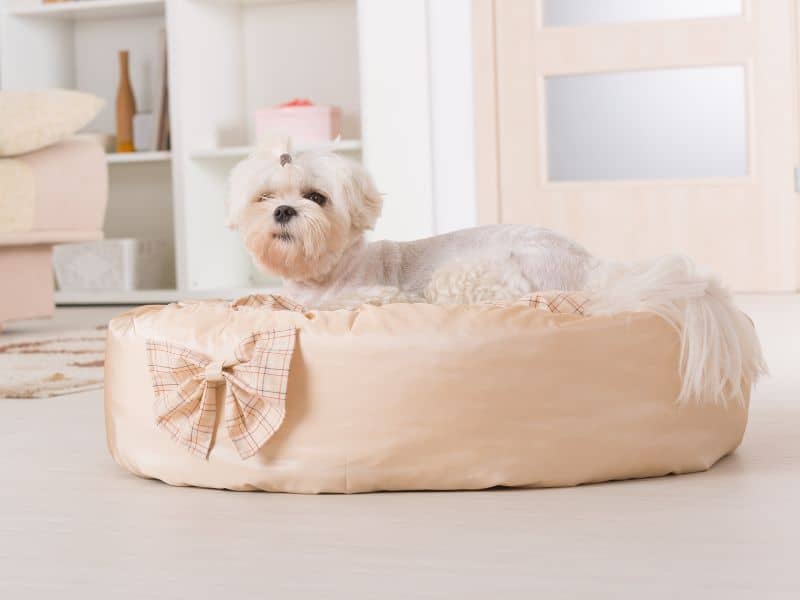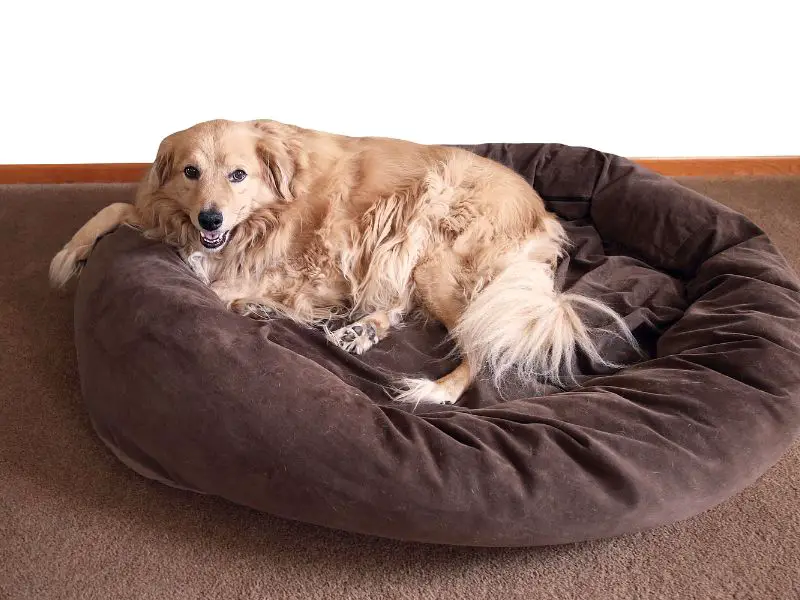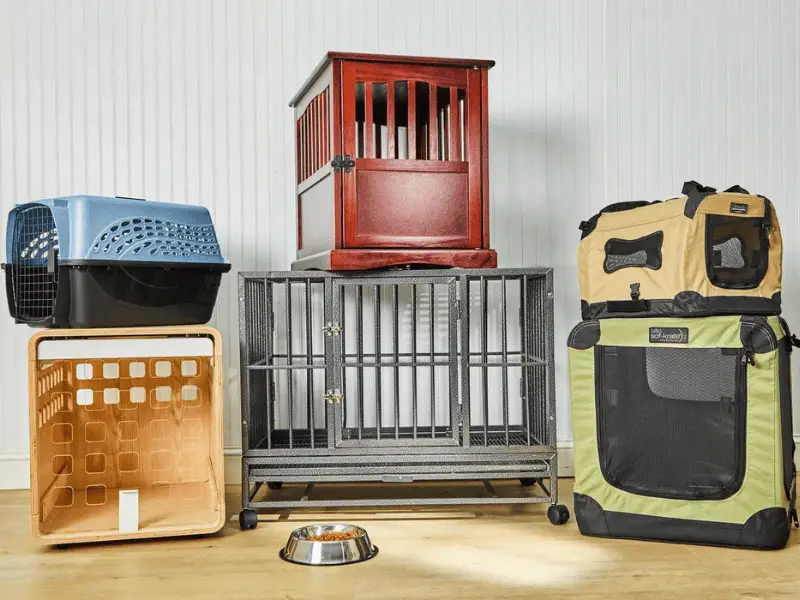Creating a comfortable and safe sleeping place for our furry friends is crucial. In this article, we will delve into the importance of providing an adequate Bed Size for Dogs that suits their needs.

We will also address the challenges faced in choosing the right dog bed, ensuring that our beloved pets can rest peacefully.
Importance of a comfortable and safe sleeping place for dogs
A good sleeping place for dogs is essential for their health and well-being. Dogs need a place to rest and reenergize after a long day. Providing a comfy and safe sleeping space is key.
Choosing the right dog bed can be tough. Many types exist. Standard beds are simple and cushioned. Nesting beds give a cozy, enclosed feeling. Orthopedic beds help with joint and muscle issues. Elevated beds keep dogs off the cold floor. Donut beds have raised sides for security.
When selecting a dog bed, you should consider size and weight. Also consider the dog’s sleeping position. Age and health are important too. Think about durability, quality, and ease of cleaning.
A good bed gives many benefits. Comfort and support lead to better sleep and better health. Orthopedic beds help with pain. Temperature regulation beds keep dogs comfortable. Having a space reduces stress and anxiety. Plus, protection from allergens and parasites.
To keep your dog bed clean and long-lasting, wash it regularly. Vacuum it to remove hair and dirt. Check for signs of wear and tear. Replace when needed for comfort and safety.
Challenges in choosing the right dog bed
Picking the correct dog bed can be hard for pet parents. With many options, it’s key to think about many factors to make the perfect choice for your pup. The main challenge is finding a bed that is both comfy and safe. Dogs have different sleeping styles and likes, so it’s important to find a bed that fits their needs.
The market has many types of dog beds, each with its own benefits and features. Standard beds give basic comfort and support. Nesting beds give a safe sleeping spot. Orthopedic beds are meant for dogs with joint or muscle pain, they offer extra cushioning and support. Elevated beds are great for hot days, and donut beds help anxious or stressed dogs feel secure.
When picking a dog bed, size and weight matter. A bed that’s too small or large won’t be comfortable or have the right support. Think about age and health too. Older dogs benefit from extra support for their joints. Quality and durability are important too, since dogs may chew or scratch their bed. Look for beds made from strong material. Cleaning is important too, so get a bed with a machine-washable cover.
A dog bed has many benefits. It gives comfort and support while sleeping, helps regulate body temperature, and can reduce stress and allergies. To keep a bed in good condition, wash it regularly and vacuum away hair and debris. Check for signs of wear and tear, and replace it if needed.
Types of Dog Beds

Discover the perfect resting spot for your furry friend as we explore the various types of dog beds. From standard beds to donut beds, each sub-section dives into the unique features and benefits that different dog beds offer. Find out which one will provide the ultimate comfort and support for your loyal companion.
Standard Beds
Standard beds are comfy, with soft materials like foam or memory foam that fit to the shape of the pup. Plus, they come with removable and washable covers for easy cleaning. Some have extras like non-slip bottoms or waterproof coatings for convenience and durability.
But, it’s key to pick the right size bed for your dog. Too small and it won’t be comfy, too big and it won’t give the support needed. Also consider your dog’s sleeping position – some stretch out, others curl up.
Pro Tip: Measure your pup from nose to tail when they’re in their favorite sleeping position to get the perfect size bed.
Nesting Beds
Nesting beds make a great choice for dogs who love cozy and secure sleeping spaces. With walls or edges that are raised, these beds give a sense of comfort and security. Dogs can curl up or lean against the edges for the perfect resting position. The soft materials provide extra cushioning and support for your pup’s body. These beds are ideal for dogs who like enclosed spaces when sleeping.
There are various sizes and designs for nesting beds to suit different breeds and sleeping preferences. Whether you have a tiny Chihuahua or a large German Shepherd, you can find the perfect nesting bed. Some even have removable covers for easy cleaning.
The design of nesting beds is unique as it simulates the feeling of a nest or den. This is great for dogs with anxiety or those who like enclosed spaces. The raised edges also offer support for the neck and head, improving their alignment when resting.
It’s crucial to choose the right size and design for your dog’s bed. When Max, a pup who loved to snuggle, got his own nesting bed, he felt a sense of security right away. He quickly made it his favorite spot for taking naps and relaxing. His bed gave him the perfect sleeping environment tailored to his preferences.
To sum it up, nesting beds are a great choice for dogs who want a secure and comfortable sleeping space. With their raised edges and soft materials, these beds offer extra cushioning and support. They also provide a unique sleeping experience by simulating the feeling of being in a nest or den. By selecting the right size and design, your dog can feel safe, comfortable, and well-rested in their nesting bed. So why not give your furry friend the luxury of a nesting bed?
Orthopedic Beds
Orthopedic beds are the paw-fect choice for dogs with joint or muscle pain. They’re specially designed with foam or memory foam to evenly distribute weight, reducing pressure on achy areas. These beds also promote better sleep and spinal alignment, making them great for older four-legged friends and larger breeds. Plus, orthopedic beds come with removable and machine-washable covers, keeping them hygienic and free from allergens.
Investing in an orthopedic bed is smart for any pup-parent wanting to prioritize their pooch’s well-being. It provides relief from pain and better sleep – giving your doggo the rest they truly deserve!
Elevated Beds
Elevated beds are great for pampering pooches! These beds are specially made for a comfy and supportive sleep. Plus, they offer better air circulation. The air under the bed keeps dogs cool and prevents overheating. This is great for hot summer days and pooches who overheat easily.
Elevated beds also help ease joint pressure. The raised design reduces strain, making it great for senior dogs or those with joint issues. It’s a comfy way to ensure your pup’s well-being.
On top of that, elevated beds are easy to clean and maintain. Most are made of durable material that can handle regular cleaning. So, pet owners don’t have to worry about spending time and effort on keeping the bed clean.
In short, elevated beds provide comfort, support, improved air circulation, and reduced joint pressure. They’re perfect for dog owners who want to prioritize their pup’s comfort. Donut beds are also a great option if you want to give your pup a sweet spot to snooze.
Donut Beds
Donut Beds are great for dog owners who want their pup to feel secure and comfy. These beds have raised edges that create a boundary. Plus, the cushioned surface gives support and comfort. Soft materials make Donut Beds ideal for dogs who like to curl up when they sleep.
The donut shape of these beds keeps body heat in. So, they are perfect for dogs who get cold or like to feel warm when they snooze. There are loads of sizes and styles, so you can find one that fits your pup and home decor.
Donut Beds have other benefits too. They give dogs their own special sleeping space, reducing stress and anxiety. This is because dogs have a natural instinct to seek out den-like areas.
Plus, Donut Beds are often recommended by vets for older dogs or ones with joint or muscle pain. The supportive bed can help relieve pressure and improve comfort. In fact, vets usually suggest Donut Beds for these dogs – according to the article ‘Choosing the Ideal Bed Size for Dogs: A Comprehensive Guide’.
When picking a bed, consider your pup’s size and weight. Get a Donut Bed that will provide the best comfort and support. Don’t let it be a pain in the neck!
Factors to Consider When Choosing a Dog Bed

When choosing a dog bed, there are several key factors to consider. From the size and weight of your furry friend to their sleeping position, age, and health, each aspect plays a significant role in providing the ideal comfort and support. Additionally, you’ll want to ensure the bed is durable, of high quality, and easy to clean. Let’s explore these essential factors in detail to help you select the perfect dog bed for your loyal companion.
Size and Weight of the Dog
The size and weight of a dog are important when considering the right bed. Their size decides the bed’s dimensions, while their weight affects the sturdiness and durability.
The reference data states various types of beds for different sizes and weights. Standard beds fit smaller to medium-sized dogs; nesting beds suit larger dogs that curl up. Orthopedic beds are for aged or heavier dogs with muscle or joint issues; they offer extra support and comfort.
Size and weight also influence the bed’s quality and durability. Heavier dogs need a sturdier bed that can withstand their weight. Larger dogs require more space to spread out comfortably.
Evaluate your dog’s size and weight when selecting a bed, for comfort and support tailored to their needs.
Pro Tip: Measure from nose to tail when fully stretched out: this gives you an accurate measurement for their bed. Oh, and don’t forget: dogs have more sleeping positions than a yoga instructor on a caffeine high!
Sleeping Position
A dog’s sleeping position is key for their health and happiness. Different dogs have different sleep styles, so it’s essential for pet owners to give them a bed that caters to their preferences. Knowing your pup’s sleep style can help you pick a bed that offers the best support and comfort for them. Here are 4 common sleeping positions:
- 1. Curled Up – Many dogs love to sleep like they would in a den or nest. Beds with high sides or donut beds give them a secure feeling.
- 2. Stretched Out – Some dogs prefer to spread out their legs while sleeping. Larger beds or orthopedic beds with ample space are good for them.
- 3. Back Sleeper – Dogs who sleep on their back often like having their belly exposed. Memory foam beds give them cushioning to support their spine.
- 4. Plush Pillow Lover – Certain dogs love pillows and cushions. Beds with padding or nesting beds make them feel comfy.
Note that sometimes dogs may use different sleeping positions. By watching your pup’s sleep style, you can make sure they get a comfortable and supportive bed. This will help them sleep peacefully and stay healthy!
Age and Health
Searching for a durable, high-quality dog bed can be like looking for a unicorn – it exists, but it’s almost unreal. To choose the right bed, consider your pup’s age and health. Older dogs may need orthopedic beds, elevated beds, or donut beds for joint pain relief. For younger dogs, standard or nesting beds provide a comfortable sleeping space. If your pup has special conditions, like incontinence or allergies, look for waterproof or hypoallergenic bedding. By doing so, you can make sure your pup’s bed is comfy and healthy.
Durability and Quality
Durability and quality are must-haves when it comes to choosing a dog bed. Select a bed made from sturdy materials that can withstand wear and tear. Quality will determine the level of comfort and support for your pup. A high-quality bed will keep its shape and provide cushioning for your pup’s joints and muscles.
Let’s look at what to consider:
- Construction: Sturdy seams and reinforced stitching to prevent tearing or unraveling. Plus, a strong frame or base to support your pup’s weight.
- Material: Durable fabrics like nylon or polyester that are resistant to scratches and tears. Waterproof or water-resistant materials can also protect the bed.
- Filling: High-quality foam or memory foam fillings are more durable and offer better support than polyester fiberfill.
- Cleaning: Easy to clean with removable, machine-washable covers or materials that are easy to wipe clean.
By taking these considerations into account, you can ensure that you choose a durable and high-quality dog bed. It will give your pup lasting comfort and support. Also, a bed that is easy to clean is important because dogs can be messy.
Ease of Cleaning
Cleaning a dog bed is an important factor to consider when picking one for your furry pal. It should be easy to clean for hygienic purposes and to ensure a healthy environment for your pet. Consider if it is machine washable, has a removable cover, is made of waterproof materials, has a durable construction, and features low-maintenance extras.
Be sure to clean all parts of the bed correctly – including foam inserts, stuffing, and all components that cannot be removed. This will prevent any buildup of dirt, allergens, and parasites that could cause health issues for both your pet and your family.
Keep the sleeping area of your pup fresh and clean to give them sweet dreams they deserve. This will also extend the lifespan of the bed. Regular cleaning helps to maintain freshness by getting rid of unpleasant odors that may develop over time.
Get a good dog bed – their joints will thank you!
Benefits of a Good Dog Bed

A good dog bed offers numerous benefits that contribute to your furry friend’s overall well-being. From providing comfort and support to offering relief from joint and muscle pain, a well-chosen bed ensures your pup gets a good night’s sleep. Additionally, it helps regulate temperature, reduces stress and anxiety, and protects against allergens and parasites. Discover how investing in the ideal dog bed can greatly enhance your beloved pet’s quality of life.
Comfort and Support
Comfort and support are key when selecting a dog bed. Just like us, doggies need a comfy and supportive sleeping space to get some quality rest. Without the right comfort and support, dogs can have pain and health complications. It’s important to give them a bed with the right cushioning and firmness for optimal comfort and support.
Dogs sleep a lot, so picking a bed that meets their comfort and support needs is a must. By giving them the right sleeping surface, you can help boost their overall health and life quality.
When considering a bed for your pup, think about:
- Sleeping Position: Look at your dog’s favorite sleep position – curling up, stretching out, or on their back. Different positions need different cushioning and support.
- Size and Weight: The bed should be the right size for your pup’s size and weight. Not too small or too large.
- Material: Choose one with high-quality materials for comfort and durability. Memory foam and orthopedic foam are great options.
- Temperature Regulation: Get one with cooling properties to keep your pup’s body temperature regulated when it’s hot out.
By following these cues when selecting a bed, your pup can have a comfortable and supportive sleeping environment tailored to their needs. Plus, they’ll thank you with a healthy body and sound sleep!
Relief from Joint and Muscle Pain
A good dog bed is essential for relieving joint and muscle pain in dogs. An orthopedic bed is the right type, providing support and cushioning. This bed has high-density foam or memory foam to spread weight evenly and reduce pressure on joints. It aligns the spine and soothes aching muscles and joints.
Senior dogs may have age-related joint stiffness or hip dysplasia. An orthopedic bed helps alleviate these symptoms. Active dogs and those recovering from injuries may also benefit from one.
These beds offer a stable surface that minimizes movement during sleep. This reduces strain on affected areas for better comfort.
Keep your dog cool in summer and warm in winter with an orthopedic bed that regulates temperature.
Temperature Regulation
A dog bed with temperature regulation is important. It stops your pet from getting too cold or hot. Here are five points to consider when looking for one:
- Insulation: Certain beds have materials that keep your pup warm in cold weather. They trap their body heat and keep them comfy.
- Breathability: Beds with breathable fabrics let air flow. This helps your dog not overheat, especially during summer.
- Cooling Features: Some beds have cooling features like gel-infused memory foam. This helps reduce their body heat, giving them more restful sleep.
- Raised Design: Elevated beds keep your pet off the ground. This improves ventilation and keeps them warm in winter.
- Climate Considerations: The climate you live in affects which bed is best for your dog. In colder climates, thicker padding is ideal. Warmer climates require beds with cooling properties and breathability.
Every dog has different temperature preferences. Speak to a veterinarian to find out which bed is best for your pet. A good bed gives your pup the stress relief they need. Life is ruff after all!
Stress and Anxiety Reduction
Stress and anxiety reduction is key for a pup’s comfort. Dogs, just like humans, can experience stress and anxiety. A supportive dog bed can create a tranquil environment to reduce this stress. Cushioning, padding and special materials like memory foam or lavender-infused fabric can all aid in relaxation.
The size and shape of the bed are also important. Different dogs have different sleeping habits. Some prefer to curl up in a nest-like bed, some stretch out. Whatever fits your pup’s style helps them feel secure.
A designated space of their own helps create a sense of security. Dogs are den animals and having a comfortable spot to retreat to when stressed helps them cope.
An appropriate bed has positive effects on physical health too. When less stressed, pups’ immune systems work better, preventing illnesses caused by chronic stress.
Therefore, when choosing a bed, consider your pup’s individual needs. The right size, shape and material create a space for them to relax and unwind. When it comes to allergens and parasites, a good dog bed is like a force field!
Protection from Allergens and Parasites
Dogs are prone to allergies and parasites like fleas and ticks. Protecting their safety and health is key. A good dog bed is essential. Hypoallergenic material prevents allergies from dust mites, pollen, or other airborne substances. Detachable covers allow for regular washing, which decreases the risk of parasites. Waterproof or water-resistant covers stop moisture build-up which attracts pests and allergens. Elevated beds keep dogs off the ground, lowering exposure to outdoor pests like ants and mosquitoes. Orthopedic beds with memory foam block allergens and parasites from entering. Donut beds with raised sides create a snug space blocking access to parasites.
Certain dog beds have built-in parasite repellent materials. These may include natural oils or insect-repelling fabrics. Certain bed designs have removable liners that resist bacterial growth, reducing infection risk from germs. To ensure optimal protection, regularly wash the bed cover using pet-friendly detergents. Vacuum the bed regularly too. Inspect the bed for signs of wear and tear, keeping an eye out for gaps or holes where pests may enter. By following these suggestions, you can provide a clean and safe sleeping environment for your dog while protecting them from allergens and parasites.
Maintenance Tips for Dog Beds
Regular maintenance is key when it comes to keeping dog beds clean and comfortable. In this section, we will explore some essential tips to ensure the longevity of your furry friend’s sleeping haven. From regular washing to checking for signs of wear and tear, we will cover everything you need to know to keep your dog’s bed in top shape. Let’s dive in and discover the best practices for maintaining dog beds.
Regular Washing
- Remove any removable covers or cushions from the dog bed.
- Check the care instructions for washing guidelines.
- Use mild detergent suitable for sensitive skin to wash the covers or cushions.
- Wash them separately from other laundry items to prevent cross-contamination.
- Choose the right cycle and temperature for the fabric of the covers or cushions.
- Properly dry them before putting them back to avoid moisture and mold.
Inspect seams, zippers and overall condition of the bed to ensure its safety and longevity. These maintenance tips help provide your pet with a clean and cozy sleeping environment.
Regular washing keeps odor-causing bacteria and allergens away. It also reduces dirt or dust particles which can cause discomfort. So, keep up with regular washing routines for a healthy and happy pup!
Finally, vacuum the bed fur-free. No one likes sleeping in a canine hairball!
Vacuuming
Vacuuming is an important part of keeping your pup’s bed clean and extending its lifespan. Vacuuming can remove debris and dust particles that may damage the fabric or material of the bed. It’s also a great way to deep clean since it can reach into crevices and corners that normal cleaning methods can’t.
Regular vacuuming helps keep dirt, hair, allergens, and parasites away. This promotes a healthier environment and prevents any potential health issues. So don’t forget to vacuum regularly for your furry friend’s ultimate comfort!
Want to keep your pup’s bed in top shape? Make sure to include vacuuming as part of your cleaning routine!
Checking for Signs of Wear and Tear
Regularly check your pup’s bed for signs of wear and tear. Look for holes, frayed edges, or loose stitching. See if the padding is still supportive and comfortable. Neglect these issues and your pooch could be in discomfort or even get injured.
To make your pup’s bed last longer:
- Rotate it often.
- Use a removable, machine washable cover.
- Keep it out of direct sunlight.
A comfortable bed is like a sunny spot – perfect for your furry friend! Regularly inspect it and make sure it’s safe and cozy. That way, your pup can rest their paws happily.
Conclusion: Choosing the Right Dog Bed for Your Furry Friend
When it comes to choosing the right bed for your furry friend, the decision can be overwhelming. In this concluding section, we’ll explore the key factors to consider, the benefits of a good dog bed for their overall well-being, the personalization options available, and provide some final thoughts to help you make the ideal choice. So, let’s dive in and ensure your canine companion enjoys the utmost comfort and support they deserve.
Importance of considering all factors
Choosing a dog bed is vital for the health and bliss of your furry friend. Size, weight, sleeping position, age, health, quality, and durability are all key considerations. Cleaning should also be easy to maintain hygiene and prevent allergens and parasites.
A comfy and safe sleeping place is essential for dogs, to ensure relaxation and good sleep. Consider the needs of your pet, for example, a larger bed with support for bigger dogs, and nesting or donut beds for smaller ones.
Take age and health conditions into account too. Older dogs or those with pain may need orthopedic beds for extra support. Elevated beds can regulate body temperature.
A dog bed can reduce stress and anxiety in dogs, as it provides a secure space. Hypoallergenic materials protect from skin irritation or respiratory issues.
Regular maintenance is needed to prolong the life of the dog bed. Wash the cover often, and vacuum to remove fur and debris. Check for wear and tear, like loose fabric or damaged padding, to avoid hazards.
Benefits of a good dog bed for overall well-being
A good dog bed can offer lots of benefits for a dog’s well-being. It’s comfortable and supportive, allowing dogs to sleep peacefully. Different types of beds cater to specific needs and preferences such as sleeping position and health conditions.
These beds can provide relief from joint and muscle pain, especially for elderly or sick dogs. Padding and materials help reduce pressure points and support better circulation. Plus, beds can regulate temperature, keeping dogs comfy during any kind of weather.
Good dog beds can also reduce stress and anxiety. Having a safe and secure place to rest helps dogs relax. Plus, they provide protection from allergens and parasites that might be present on other surfaces.
Choosing the right bed is key for a dog’s well-being. You should take size, weight, sleeping position, age, health condition, durability, quality, ease of cleaning, and personalization options into account. Don’t forget regular washing and vacuuming to keep the bed clean. And why not add a personal touch with customization options? Your pup will feel like royalty!
Personalization options
Dog beds can be customized in a variety of ways! Inserts can be customized with materials like memory foam or orthopedic foam to suit different sizes and breeds. Design options include colors, patterns, and personalized embroidery or tags. Removable covers make cleaning easy and adjustable heights provide comfort for getting in and out of bed. Convertible beds can be configured to fit specific preferences and extra accessories like attachable pillows and bolsters can be added for extra comfort. Specialized features such as heating elements or speakers provide unique personalization for a tailored sleeping experience.
Owners can create a cozy and safe space for their furry friends to relax and unwind.
Final thoughts
It’s important to consider various factors when choosing the perfect bed size for your pup. Size/weight, sleeping position, age, health, durability, quality, ease of cleaning – all of these are key. Plus, personalization options like color or design can add a touch of style. Make an informed decision and your pup will be sure to enjoy a restful sleep!
I remember when I had to find the right bed size for Max. He was a large breed with special needs – it took time to find an orthopedic bed that would provide him with comfort and support. But when I did, it made a huge difference in his life! His joint pain was reduced, he slept well, and seemed calmer and happier.
So, take the time to choose the ideal bed size for your furry friend – they will be thankful!
Some Facts About Choosing the Ideal Bed Size for Dogs: A Comprehensive Guide
- Choosing the right bed size is important to ensure your dog’s comfort and support while sleeping.
- Measuring your dog is crucial to determine the right bed size. Measure from the tip of the nose to the base of the tail and add a few inches for the perfect fit.
- Consider your dog’s sleeping position and habits when selecting a bed size. Dogs that like to stretch out may require a larger bed, while those that prefer to curl up can do with a smaller size.
- It is recommended to choose a bed that is at least 6 inches longer than your dog’s length from the tip of the nose to the base of the tail for ample space.
- Investing in the right bed size ensures your dog’s comfort, promotes better sleep, and supports their joints and muscles.



Leave a Reply